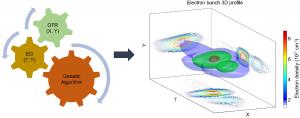Electro-optic 3D snapshot of a laser wakefield accelerated kilo-ampere electron bunch
USA, April 9, 2024 /EINPresswire.com/ -- Laser wakefield acceleration has garnered widespread attention for its ability to achieve ultrahigh acceleration gradients and generate high-brightness electron bunches. However, one crucial parameter, the three-dimensional (3D) density of the electron bunch, has remained elusive in experimental investigations—until now. Scientists in Japan achieved a breakthrough by developing an innovative electro-optic technique capable of conducting the three-dimensional snapshot of a laser wakefield electron bunch, outside the plasma.
Invented by T. Tajima and J. Dawson, laser wakefield acceleration (LWFA) harnesses the power of high-intensity laser pulses to drive plasma waves with acceleration gradients orders of magnitude higher than conventional RF-based accelerators. Treating the laser pulse as a bullet, the ponderomotive force induces a periodic wave in plasma, akin to an RF cavity. Electrons trapped in this wave can reach energies of GeV (1 GeV = 109 eV) within a mere centimeter— a thousand times shorter than conventional accelerators. The femtosecond temporal durations of electron bunches from LWFA present unprecedented opportunities for ultrafast studies. Over the past two decades, LWFA has seen remarkable advancements in maximum energy, energy spread, charge, and repetition rate.
With its high acceleration gradient and ability to produce high-brightness electron bunches, LWFA holds immense potential for applications in high-energy physics, X-ray pump-probe studies, and time-resolved dosimetry. The three-dimensional (3D) density is a critical parameter influencing the luminosity in a collider, the brightness of secondary X-ray sources, and the peak dose rates of radiation, respectively. In particular, a tabletop X-ray free-electron laser (XFEL) is intricately linked to the lasing process in an undulator. However, until now, experimental measurement has remained elusive due to the lack of diagnostic methods. While transverse or relative longitudinal distributions have been studied separately, the absolute 3D density profile has yet to be fully characterized.
In a new paper (doi: 10.1038/s41377-024-01440-2) published in Light Science & Application, a team of scientists, led by Dr. Masaki Kando from Kansai Institute for Photon Science (KPSI), National Institutes for Quantum Science and Technology (QST), Japan, Prof. Tomonao Hosokai from SANKEN, Osaka University, Japan, and co-workers have achieved a breakthrough in the single-shot monitoring of the 3D density profile of LWFA electron bunches. Via challenging effort of experimental and numerical investigations on the optical transition radiation (OTR) imaging, electro-optic (EO) spatial decoding, and genetic algorithm (GA), the detailed 3D structures of the ultrafast electron bunches from LWFA were successfully reconstructed, illuminating the intricate beam dynamics of the electron bunch.
The findings reveal a transverse size of less than 30 micrometers for the electron bunch, showing the remarkable resolution achieved by the OTR imaging technique. Moreover, the current profile exhibited a complex multi-peak shape, with a sub-10 femtosecond structure boasting a peak current exceeding 1 kiloampere (kA)—a testament to the exceptional performance of laser wakefield acceleration. Of particular significance is the observed peak 3D number density of ∼ 9 × 1021 m-3, offering invaluable insights into the accelerated electron bunch. This groundbreaking detection showed the potential for implementing a detector at any position along a beam transport line, thus opening new avenues for future applications in accelerator science and beyond.
“The ability to measure the three-dimensional density profile of electron bunches will enhance our understanding of LWFA and unlock its full potential for diverse applications,” said Dr. Kai Huang, senior researcher at QST and the lead author of the paper. “The results and methodologies presented in this article have far-reaching implications across a spectrum of disciplines, including accelerator physics, high-power lasers, and terahertz optics.”
The publication of this study highlights QST’s commitment to advancing quantum science and technology, creating world-leading research and development platforms, and exploring new fields, thereby achieving significant academic, social, and economic impacts.
DOI
10.1038/s41377-024-01440-2
Original Source URL
https://doi.org/10.1038/s41377-024-01440-2
Funding information
This work was funded by the JST-Mirai Program Grant No. JPMJMI17A1, Japan, JSPS KAKENHI (No. JP21K17998, No. JP23K17152, No. JP22K12665), Japan and the QST President’s Strategic Grant (Exploratory Research), Japan.
Lucy Wang
BioDesign Research
email us here
Legal Disclaimer:
EIN Presswire provides this news content "as is" without warranty of any kind. We do not accept any responsibility or liability for the accuracy, content, images, videos, licenses, completeness, legality, or reliability of the information contained in this article. If you have any complaints or copyright issues related to this article, kindly contact the author above.


